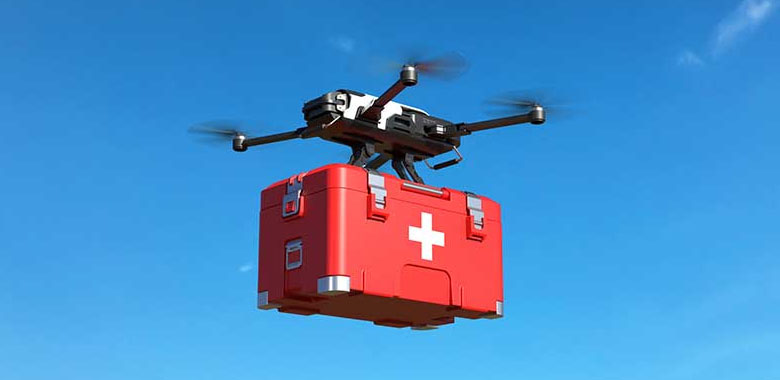
Technology has revolutionised every aspect of human endeavour. In health care, several artificial intelligence tools have aided the fast, accurate and quick detection of ailments, thereby offering medical practitioners ease in the diagnosis and treatment of patients.
Residents in remote and rural areas were mostly bereft of access to health facilities, practitioners or medications. But AI and robotics became game changers in the delivery and disbursement of medicines.
Remote locations are difficult to reach and have harder means to access basic humanitarian services.
Low population density, absence of relevant medical facilities such as clinics and hospitals, lack of functioning transport links and infrastructure and difficult terrains, are features of such areas.
These make rural dwellers suffer inadequate health facilities and live at the mercy of traditional medical practitioners.
According to the World Bank, Nigeria’s rural population in 2021 was 47.25 per cent.
According to the National Primary Healthcare Development Agency, six of 10 Nigerians lack quality primary health care services, while only 43 per cent has access to quality services.
Emerging health technologies, such as unmanned aerial vehicles, also known as drones, are currently providing the solution to reaching underserved rural communities with medicines and vaccines.
A drone, according to an online community of tech companies, is an “aerial vehicle that receives remote commands from a pilot or relies on software for autonomous flight.”
This robotic tool has display features like cameras for collecting visual data and propellers for stabilising flight patterns.
Drones, before now, were used by the military for surveillance and monitoring.
Over time, their use evolved to agriculture, checking crop health and watering plants. It further extended to cinematography, transportation, identifying hotspots during fire incidents, and retail and logistics, among others.
Undoubtedly, developed countries such as China, Japan, the United States of America, and Australia, have blazed the trail in drone deliveries.
Remote areas in African countries such as Rwanda, Ghana, Cote D’Ivoire and recently joined Nigeria, are using these unmanned aerial vehicles, in the delivery of medical supplies and test samples.
Blazing the trail in Africa and Nigeria is a logistics and delivery company, Zipline.
Through the use of drones, the company delivers medications and supplies, moves samples from a delivery point to the laboratory, and vaccines to their destinations, among other non-medical supplies.
The autonomous electronic drone called, Zips, was built with hard and software made to endure weather conditions.
According to its website, to increase access and reduce medical waste, key stock of blood products, vaccines and life-saving medications are stored at Zipline’s distribution centers for just-in-time delivery. Health workers place orders by text message or call and promptly receive their deliveries exactly when and where they need them in 30 minutes on average.
The drones both take off from and land at Zipline’s distribution hub, requiring no additional infrastructure or manpower at the clinics they serve. The drones fly autonomously and can carry 1.8 kilos of cargo, cruising at 110 kilometers an hour, and have a round trip range of 160 kilometers – even in high speed winds and rain.
Deliveries are made from the sky, with the drone descending to a safe height above the ground and releasing a box of medicine by parachute to a designated spot at the health centers it serves.
Each aircraft can fly 160 km round trip, in strong winds and rain, day or night, to make on-demand deliveries in 30 minutes on average. Zipline’s drones have flown several million autonomous miles to deliver millions of doses of vaccines, units of blood, and critical and life saving medications to thousands of health facilities serving more than 25 million people across three countries.
Currently, Zipline operates in Kaduna, Bayelsa and Cross River states, where it recently delivered immunisation vaccines to multiple healthcare facilities.
In June, the firm, in partnership with the Cross River State government, delivered over 5,000 doses of vaccines to hard to reach areas in the state.
The delivery, according to some media reports, facilitated the prompt administration of vaccines to babies who had previously missed them due to the unavailability of the vaccines.
Parents also witnessed relief from having to commute to and fro health centres to queue for hours for vaccines for their babies only to be told to return at a later time because the available vaccines were exhausted.
In Ghana, Zipline has completed over 370000 deliveries of medical products, blood supplies, vaccines and animal health commodities in Ghana. This entails almost 11-million units of vaccines, 5-million units of medical supplies, Ghanaweb, a news medium stated.
Prompt access to health practitioners and medical supplies in remote and rural areas in some states of the country is a task yet to be surmounted.
Commenting on the issue, an unmanned aerial systems specialist and Managing Director, Aero Recon Productions, Mr Frank Nnaji, stated that drones were an efficient tool when controlled by an experienced operator or pilot but a dangerous tool in the hands of the wrong persons.
Nnaji stated that drones properly designed for medical deliveries were useful and safe.
“It is a big problem solver in that area (medical deliveries) especially because of how fast and precise they can be in gathering data and moving to a particular location. A drone can be properly designed to take into account vibrations. A lot of drones have vibration dampers, barometers and sensors that compensate for the vibration that comes from motors and other external variables. A properly designed drone takes into account all these things that can be a hindrance to the safe delivery of medical supplies,” he added.
He noted that during emergencies, drones could offer hope and “shine”.
Nnaji said, “Drones are, however, not the future of medicine since they cannot carry a doctor to a site though they can carry supplies. We are still far from that sort of technology being available. Other means are cost-efficient that can carry a doctor from point A to point B. The truth is that drones are expensive and their use in medicine is considering their usefulness rather than the price.”
He said the involvement of the government, non-governmental and state agencies could help to subsidise the cost of deliveries to patients or medical facilities.
“They operate in a very niche environment, talking about rural areas where that type of medical delivery makes sense. When you calculate the amount of money that would be spent to take supplies from point A to point B, you just have to take away the economic factor and look at the lives that are being saved. The government has to come into it because no one with their finances would afford it. After all, drones are quite expensive to operate,” the drone specialist said.
He further called for the implementation of measures to ensure efficiency in the system and accessibility and price reduction of the technology.
On his part, a pharmacist and professor of Pharmacoeconomics and Social Pharmacy, Ismail Suleiman, stated that the use of drones in the transfer and logistics of drug delivery “aided and added professionalism” to the supply and logistics of medical supplies.
He further said the speed and short delivery time of drones were an advantage in delivering medical supplies and samples with specific temperatures and packaging.
The don said, “The use of drones is aiding and adding to our professionalism. It bypasses the lag time, transportation troubles and difficult terrains. But we also need to consider the cost of the drone and its impact on the item, the number of items it can carry, the maximum capacity, the distance it can cover and the weight.”
Suleiman, who stated that he was trained in supply chain and logistics in drug delivery, explained that medical supplies, especially drugs, had several layers of protective packaging.
He, however, noted that medical delivery drones should be environmentally friendly with low and non-harmful radiation.
The researcher said, “The packaging of drugs is at different levels. We have the micro-packaging within the drugs themselves. Some drugs are in sachets and some of those transparent materials will prevent the entrance of some emissions into the drugs. These drugs are then put in packets, while some have aluminium wrappers which may not allow radiation to enter. Some drugs come with preservatives to prevent some microorganisms in the air from destroying them.
“We have what we call frequency in radioactivity. If we have high frequency, this is very punchy and will enter fast but some of the radiation may be weak, so the packaging of medical supplies being carried has solved a lot of problems that whatever radiation is being emitted will not be able to penetrate on the one hand.
“On the other hand, the materials used in making the drones would not be such that emits unnecessary radiation that would destroy the environment. If it is, that is a challenge for them to improve on their product.”
He explained that medical supplies not placed in a proper temperature setting would lose their efficiency.
Suleiman stressed that the drone’s capacity was a limitation to its ability to deliver heavy medical supplies and vaccines that needed to be in a heavy ice pack.
Speaking with our correspondent, the General Manager for Zipline Nigeria, Ms Catherine Odiase, stated that the technology had helped to provide prompt and crucially needed medical supplies.
She added that the state-of-the art, Standard Organisation of Nigeria and Pharmaceutical Council of Nigeria approved warehouse ensured medical supplies and drugs were stored in and delivered to hospitals in dire need of it.
Odiase said, “In instances where a hospital or health facility does not have a particular drug, blood or vaccines, an order is made and we deliver them safely and with speed. We have taken delivery of these medical products from government assigned entities which we deliver to the health facilities. By this, health facilities or patients do not make any payment to Zipline. Governments or states only pay delivery fees to Zipline based on an agreed contract”
She further added that the delivery system did not affect the quality of the products because they were packaged in accordance with the required temperature and packaging of the drugs.





